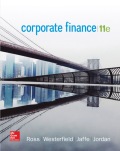
a)
To determine:
Introduction:
Accounting break-even point refers to a point where the company faces zero profits.
b)
To determine: Internal rate of return, payback period, net
Introduction:
Cash break-even point occurs when minimum revenue from sales is required to fetch the business with positive cash flows.
c)
To determine: Internal rate of return, payback period, net present value at the point of financial break-even level of output.
Introduction:
Financial break-even point refers to the point of earnings before interest and taxes (EBIT), which is equal to the fixed financial cost inclusive of preference dividend and interest.
Want to see the full answer?
Check out a sample textbook solution
Chapter 7 Solutions
EBK CORPORATE FINANCE
- You bought a bond five years ago for $935 per bond. The bond is now selling for $980. It also paid $75 in interest per year, which you reinvested in the bond. Calculate the realized rate of return earned on this bond. I want to learn how to solve this on my financial calculator. Can you show me how to solve it through there.arrow_forwardWhat are the Cases Not Readily Bound and what is a Dignity in a Research Study? What are the differences between Dignity in a Research Study and Cases Not Readily Bound? Please help to give examples.arrow_forwardWhat are the Case Study Research Design Components. Please help to give examplesWhat are the Case Study Design Tests and Tactics and how would they do?arrow_forward
- Describe some different types of ratios and how they are used to assess performance. Explain the components of the formula and the order of operations to calculate them. Discuss what these ratios say about the financial health of the organization. Determine why it is sometimes misleading to compare a company's financial ratios with those of other firms that operate within the same industry.arrow_forwardIs there retained earning statement an important financial statement at the income statement and or the cash flows statement?arrow_forward2-13. (Term structure of interest rates) You want to invest your savings of $20,000 in government securities for the next 2 years. Currently, you can invest either in a secu- rity that pays interest of 8% per year for the next 2 years or in a security that matures in 1 year but pays only 6% interest. If you make the latter choice, you would then reinvest your savings at the end of the first year for another year. Why might you choose to make the investment in the 1-year security that pays an interest rate of only 6%, as opposed to investing in the 2-year security pay- ing 8%? Provide numerical support for your answer. Which theory of term structure have you supported in your answer? 2-14. (Yield curve) If yields on Treasury securities were currently as follows: TERM YIELD 6 months 1.0% 1 year 1.7% 2 years 2.1% 3 years 2.4% 4 years 2.7% 5 years 2.9% 10 years 3.5% 15 years 3.9% 20 years 4.0% 30 years 4.1% a. Plot the yield curve. b. Explain this yield curve using the unbiased…arrow_forward
- What is the holistic case study format, could you please provide an example?arrow_forwardDescription Discuss in detail the Goal(s) of the firm. Additionally, List and discuss the 5 principles that form the foundations of finance. Lastly, List and discuss the various legal forms of business organizations.arrow_forwardWhat is the purpose of a case studty? Why is it important for researchers? Please give the examplesarrow_forward
 Intermediate Financial Management (MindTap Course...FinanceISBN:9781337395083Author:Eugene F. Brigham, Phillip R. DavesPublisher:Cengage Learning
Intermediate Financial Management (MindTap Course...FinanceISBN:9781337395083Author:Eugene F. Brigham, Phillip R. DavesPublisher:Cengage Learning

